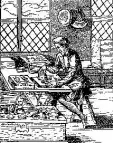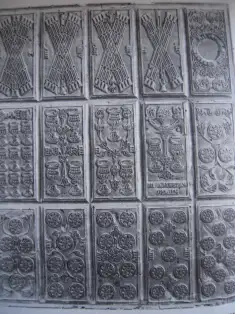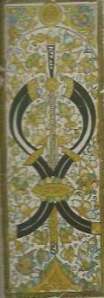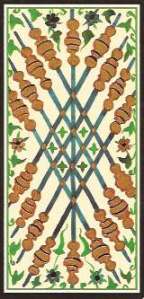Before Tarot 1375-1420
 Before the game of tarot could be invented and popularized, certain conditions had to be in place: inexpensive paper, cheap and easy printing methods, the concept of playing games with squares of paper, trade networks to distribute mass-produced decks and a dense urban population to buy them. All of these conditions came together in Europe, especially Italy, in the last quarter of the fourteenth century. Tarot made its appearance as soon as conditions allowed; it couldn’t have happened any earlier.
Before the game of tarot could be invented and popularized, certain conditions had to be in place: inexpensive paper, cheap and easy printing methods, the concept of playing games with squares of paper, trade networks to distribute mass-produced decks and a dense urban population to buy them. All of these conditions came together in Europe, especially Italy, in the last quarter of the fourteenth century. Tarot made its appearance as soon as conditions allowed; it couldn’t have happened any earlier.
Paper
Before learning how to make paper, Europeans created hand written, illuminated manuscripts on animal skin vellum. Books were costly handcrafted objects housed in castles and monasteries. Vellum doesn’t absorb printer’s ink, so images couldn’t be mass produced until paper from plant fibers became available. Techniques for making paper from cotton and linen traveled from China along the Silk Road to Central Asia and then spread throughout the Islamic world. Crusaders may have brought paper-making techniques back from the Middle East, or paper could have traveled to Europe from Islamic Spain. The first Italian paper mills appeared in 1215.
 Wood Block Printing
Wood Block Printing
Block printing is similar to rubber stamping. An image is drawn on a block of fine-grained wood like pear, apple or pine, then the background is cut away, leaving a raised image which is then covered with ink. A paper is laid on top of the inked block and rubbed with a flat metal tool to transfer the ink. This technique was originally used for printing cloth, and then was adapted to plant fiber paper when it became available. Block printing was used first for religious scenes and images of saints that people pasted into books, tacked on their walls, or carried around as talismans. As soon as card playing became popular, printers adapted their workshops to card production. The blocks could be quite large, with several columns of cards carved into one block of wood. After printing, the cards were cut apart and colored by hand using stencils. Block printing was the preferred method for printing playing cards, except for a few engraved luxury decks, until the invention of modern printing methods in the 19th century.
 Playing Cards
Playing Cards
Card playing traveled from China down the Silk Road to the Islamic world, where decks took a far different form than in China. The Topkapi museum in Istanbul has three partial decks of 15th century Islamic playing cards, named Mamluk cards after the dominant Islamic empire of the time. The deck is comprised of four suits numbered one through ten, with three court cards: King, Viceroy and Second Viceroy. The suits are curved scimitars, polo sticks, cups and coins. Because of Islamic prohibition against depicting human images, court cards are suit symbols with a label identifying their rank.
Merchants, diplomats and sailors brought playing cards to Spanish and Italian ports from Islamic countries shortly before 1370. Card games spread quickly throughout Europe, and for many decades were associated in the popular mind with Islamic culture. They were often referred to as “Moorish” or “Saracen” cards, or with the mangled Arabic word naip, naibi, or nahipi.
In Europe, the Islamic suit symbols were modified into the Italian suits of swords, batons, cups, and coins. These suit symbols are still used for Marseille-style decks and are the basis for the suit symbols in Rider-Waite-Smith style decks. Court cards were redesigned to depict actual people, King, Queen, Knight and Page.
 Card Playing in Europe
Card Playing in Europe
Card playing spread across Europe very quickly, and by the 1370s became so rampant that an alarmed establishment saw it as a social problem. Even though no actual cards remain from that time, we know card playing was widespread because of written evidence in city ordinances, sermons that denounced card playing and other working class vices, account books and merchant’s inventories. In 1376 Florence, Naibe-type games were forbidden in language that implies the games were new on the scene. A Dominican priest living in Basle in 1377 described a deck of playing cards with suits numbered 1 to 10 and 3 court carts. A 1401 merchant’s inventory in Barcelona mentions gilded cards.
Trump Cards
In trick-taking games, a player leads with a card, and the rest of the players have to lay down a card of the same suit, if they have one. If not, they must play any card of another suit and forfeit it. Whoever plays the highest card of the suit that was led wins the hand. To make the game more interesting, one of the suits can be designated as a “trump” suit, meaning its cards rank higher than any card in the other three suits. If you don’t have a card of the suit that was led, you can play a card from the trump suit and take the hand.
 In some places, it was customary to give names to the trump suit cards. In Karnoffell, a game that was very popular in German-speaking regions by the 1420s, the trump cards were called names like Devil, Emperor, and Pope. There is no evidence that Karnoffel directly influenced Tarot, but it shows that some Tarot images may be rooted in folk traditions surrounding card playing.
In some places, it was customary to give names to the trump suit cards. In Karnoffell, a game that was very popular in German-speaking regions by the 1420s, the trump cards were called names like Devil, Emperor, and Pope. There is no evidence that Karnoffel directly influenced Tarot, but it shows that some Tarot images may be rooted in folk traditions surrounding card playing.
The game of Tarot is unique in having a fifth suit that serves as a permanent trump suit. On the next page we’ll see how this suit of Triumphs was invented.

